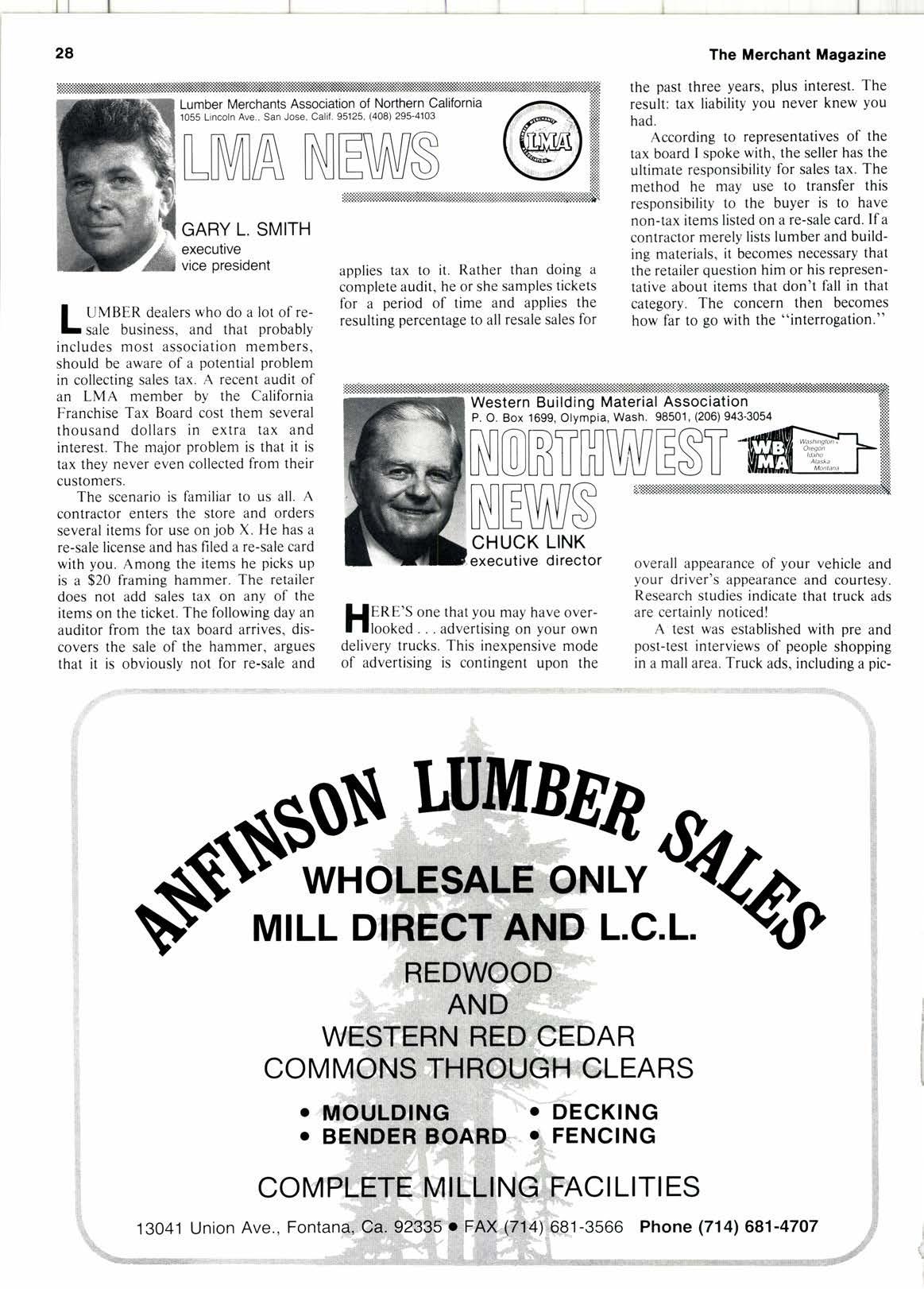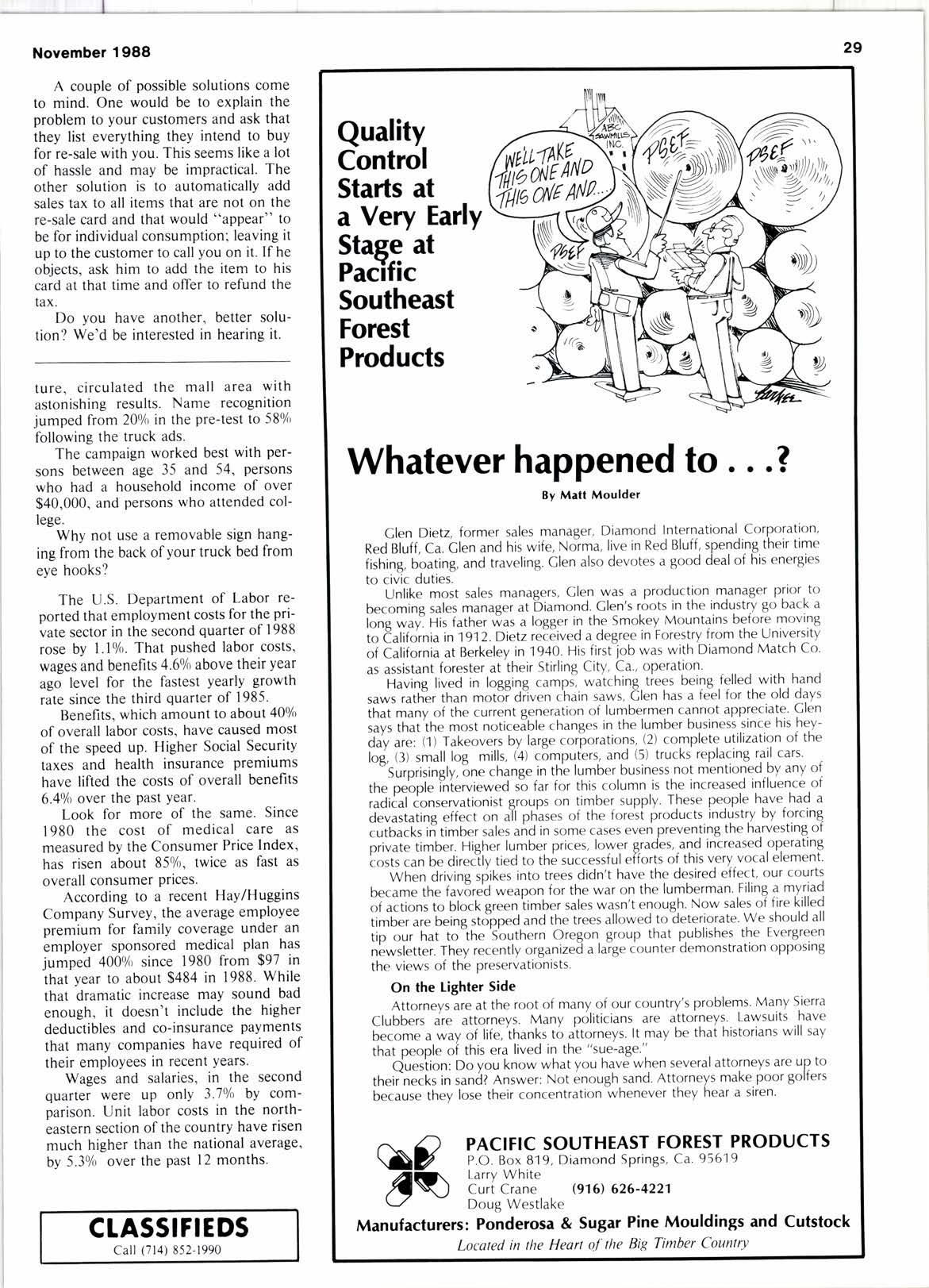
3 minute read
Western Red Cedar Lumber Association
GARY L. SMITH executive vice oresident
I UVef n dealers who do a lot of reb sale business, and that probably includes most association members, should be aware ol a potential problem in collecting sales tax. A recent audit of an LMA member by the California Franchise Tax Board cost them several thousand dollars in extra tax and interest. The major problem is that it is tax they never even collected from their customers.
The scenario is lamiliar to us all. A contractor enters the store and orders several items for use on job X. He has a re-sale license and has filed a re-sale card with you. Among the items he picks up is a $20 framing hammer. The retailer does not add sales tax on any of the items on the ticket. The following day an auditor from the tax board arrives, discovers the sale of the hammer, argues that it is obviously not for re-sale and applies tax to it. Rather than doing a complete audit, he or she samples tickets for a period of time and applies the resulting percentage to all resale sales for the past three years, plus interest. The result: tax liability you never knew you had.
According to representatives of the tax board I spoke with, the seller has the ultimate responsibility for sales tax. The method he may use to transfer this responsibility to the buyer is to have non-tax items listed on a re-sale card. If a contractor merely lists lumber and building materials, it becomes necessary that the retailer question him or his representative about items that don't fall in that category. The concern then becomes how far to go with the "interrogation."
LIERE'S one that you may have overI llooked advertising on your own delivery trucks. This inexpensive mode of advertising is contingent upon the overall appearance of your vehicle and your driver's appearance and courtesy. Research studies indicate that truck ads are certainly noticed!
A test was established with pre and post-test interviews of people shopping in a mall area. Truck ads, including a pic-
November 1988

A couple of possible solutions come to mind. One would be to exPlain the problem to your customers and ask that they list everything they intend to buy for re-sale with you. This seems like a lot of hassle and may be impractical. The other solution is to automatically add sales tax to all items that are not on the re-sale card and that would "appear" to be for individual consumption; leaving it up to the customer to call you on it. If he objects, ask him to add the item to his card at that time and offer to refund the tax.
Do you have another, better solution? We'd be interested in hearing it.
ture, circulated the mall area with astonishing results. Name recognition jumped from 200/o in the pre-test to 58% following the truck ads.
The campaign worked best with Persons between age 35 and 54, Persons who had a household income of over $40,000, and persons who attended college.
Why not use a removable sign hanging from the back ofyour truck bed from eye hooks?
The U.S. DePartment of Labor reported that employment costs for the private sector in the second quarter of 1988 rose by 1.10/0. That pushed labor costs' wages and benefits 4.60/o above their year ago level for the lastest yearly growth rate since the third quarter of 1985.
Benefits, which amount to about 400/o of overall labor costs, have caused most of the speed up. Higher Social Security taxes and health insurance premiums have lifted the costs of overall benefits 6.40/o over the past year.
Look for more of the same. Since 1980 the cost of medical care as measured by the Consumer Price Index, has risen about 85%, twice as fast as overall consumer Prices.
According to a recent HaylHuggins Company Survey, the average employee premium for family coverage under an employer sponsored medical plan has jumped 4000/o since 1980 from $97 in that year to about $484 in 1988' While that dramatic increase may sound bad enough, it doesn't include the higher deductibles and co-insurance payments that many companies have required of their employees in recent Years.
Wages and salaries, in the second quarter were uP onlY 3.70lo bY comparison. Unit labor costs in the northeastern section of the country have risen much higher than the national average, by 5.3% over the Past 12 months.










